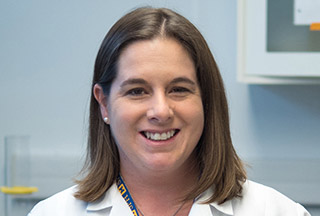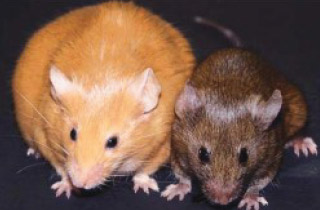March 11, 2022
With funding from the NIEHS RIVER Program, Dana Dolinoy, Ph.D., is developing new ways to reverse the effects of toxic exposure and improve health.

As an undergraduate, Dana Dolinoy, Ph.D., heard surprising news stories about frogs with deformities found at a higher rates than expected. She also noticed fewer animals in estuaries she used to visit in her hometown, both of which inspired Dolinoy’s interest in how the environment affects health.
Later in graduate school, Dolinoy worked with Randy Jirtle, Ph.D., to study how exposure to chemicals in the diet alter gene expression without directly changing DNA in agouti mice. These variations, known as epigenetic changes, can occur throughout life, but especially during prenatal development.
"I began to realize we were missing an important link in understanding how our environment interacts with our genes," said Dolinoy. "That's when I became interested in studying the epigenome."
A publication stemming from her doctoral research on the epigenome was awarded the 2011 Environmental Health Perspectives Classic Paper of the Year. Since then, she's continued to explore the intersection of the environment, nutrition, and the epigenome across the lifespan.
Dolinoy’s work has since focused on the overlap between the epigenome, nutrition, and the environment across the lifespan.
From Mice to People

“The epigenome varies in different parts of the body and even in different cells in the same part of the body. I do research with mice and with human DNA from blood or saliva to try to find similarities that will help us better link data from animal studies with potential effects on human health,” says Dolinoy.
Dolinoy found that prenatal exposure to bisphenol A (BPA) altered gene expression in agouti mice towards yellow coats, but that supplements like folic acid protected offspring from these changes. Her more recent research in birth cohorts has also shown a connection between BPA exposure and epigenetic changes in humans.
Today, Dolinoy is collaborating with researchers across the country to better understand the interaction between environmental exposures, the epigenome, and human disease as part of the NIEHS TaRGET II (Toxicant Exposures and Responses by Genomic and Epigenomic Regulators of Transcription) Consortium.
"The TaRGET II Consortium is shedding light on the underlying mechanisms by which different exposures alter gene expression," she said. "Building off the first phase of the program, my colleagues and I are pinpointing epigenetic signatures that can predict changes in specific organs. For example, we want to know if changes measured in blood samples are related to those in the liver, brain, or heart, which may lead to disease."
Developing New Techniques to Modify the Epigenome
In addition to identifying how toxicants affect the epigenome, Dolinoy is exploring cutting-edge strategies to reverse damage.
“Because the epigenome can be modified, I hope to find ways to utilize it to improve health,” she explains. “The tools we currently have to reverse harmful epigenetic changes are crude, like sledgehammers. But new approaches can focus on a more sophisticated way to turn genes on or off.”
Dolinoy and collaborators are working to develop a new approach to edit the epigenome. The approach uses a type of small, non-coding RNA called piRNA that helps trigger certain beneficial epigenetic changes. Non-coding RNA are not translated into proteins, but instead carry out very important functions.
“The ‘pi’ stands for P-element Induced Wimpy testis, because knocking it out in the Drosophila fly leads to fertility issues,” Dolinoy explains. “We knew the four specific sites on DNA that need to be altered to prevent the agouti mice from turning yellow and becoming obese, but we wanted to know if we could engineer piRNA to go in and change those sites.”
Dolinoy was awarded the 2015 NIH Transformative Research Award to study just that.
“This funding was pivotal because it allowed us to explore and apply such a novel concept to environmental health,” she says. “In the long term, we hope to use piRNA to develop targeted therapies that alter epigenetics and gene expression to improve health. This could change how diseases like cancer are treated.”
Interdisciplinary Collaborations and Mentoring the Next Generation
In 2020, Dolinoy was recognized with the prestigious NIEHS Revolutionizing Innovative, Visionary Environmental Health Research (RIVER) award. These grants support outstanding scientists, giving them freedom and flexibility to follow research questions in new and innovative directions.
"The RIVER award gave me a unique opportunity to create the DoGoodS-Pi lab in collaboration with Jackie Goodrich, Ph.D., Laurie Svoboda, Ph.D., and Bambarendage Pinithi Perera, Ph.D.," Dolinoy explains. "I feel fortunate to work with three other women scientists and continue exploring how targeted epigenetic changes can protect against environmental insults."
Dolinoy has many accolades and is pushing the field of epigenetics forward. Of her many joys from research, one of the highest is working with early-career scientists.
“I’m proud that I get to go to work every day and mentor,” shares Dolinoy. “My goal is to give students the foundation to become independent scientists.”
Dolinoy also encourages early-career scientists to think about how research affects communities.
“As scientists we should strive to translate our research into tangible improvements in health and wellbeing,” she says. “One way we can do that is through partnering with communities and getting students and trainees involved. Early exposure to the possibilities of community partnerships will reduce the barriers for community-engagement for early-career scholars.”


